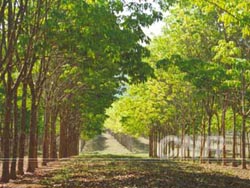
As China's major planting base for the rubber tree (
Hevea brasiliensis), Xishuangbanna in southwest China's Yunnan Province has made tremendous contributions to the national economic growth. However, because the lands suitable for rubber plantations are distributed in tropical rainforests, the increasing rubber plantations have led to the acreage reduction of the local rainforests. These may irreversibly alter the local ecological and environment systems, producing direct or indirect impact on climate. Of them, the changes in atmospheric chemistry are caused by the differences between biogenic volatile organic compounds (VOC) from rubber plantations and those of natural vegetation.
Emissions of VOC have played an important role in ecophysiology and atmospheric chemistry at a wide range of spatial and temporal scales. Tropical regions are a major global source of VOC emissions, and magnitude and chemical speciation of VOC emissions are highly plant-species specific. Therefore it is important to study emissions from dominant species in tropical regions undergoing large-scale land-use change, for example, rubber plantations in Southeast Asia. Rubber trees are strong emitters of light-dependent monoterpenes.
As reported in a recent issue of
Global Change Biology, a recent study by researchers from the CAS Xishuangbanna Tropical Garden (XSTG) reveals the characteristics of VOC emissions in local rubber plantations.
Teaming up with co-workers from UK and Spain, Prof. LI Qingjun and his graduate student WANG Yongfeng from XSBG made measurements of emissions from leaves in the dry season in February 2003 and at the beginning of the wet season in May 2005, respectively. They discovered that major emitted compounds were sabinene, α-pinene and β-pinene, but β-ocimene and linalool also contributed significantly at low temperature and light.
Cis-ocimene was emitted with a circadian course independent of photosynthetic active radiation (PAR) and temperature changes with a maximum in the middle of the day. Total isoprenoid VOC emission potential at the beginning of the wet season ( 94μg gdw−1 h−1) was almost two orders of magnitude higher than measured in the dry season (2 μg -h-1). Their study showed that composition of the total emissions changed with rising temperature or PAR ramps imposed throughout a day. As well as light and temperature, there was evidence that assimilation rate was also a factor contributing to seasonal regulating emission potential of monoterpenes from rubber trees.
Their work contributes to a better understanding of an important source of biogenic VOC associated with land-use change in tropical Southeast Asia.





